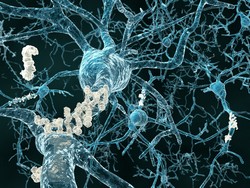Protein interaction in neurodegeneration
Protein aggregation is the hallmark of various neurodegenerative disorders such as Alzheimer's (AD) and Parkinson's diseases (PD). Amyloid β (Aβ) and tau proteins form aggregates in AD and α-synuclein aggregation is seen in PD. Intriguing recent evidence demonstrates the synergistic interactions between α-synuclein and tau, Aβ and tau, and α-synuclein and Aβ amyloid oligomers. However, the mechanism underlying this paired protein aggregation remains controversial, as which domains in these proteins interact is not completely understood. The scope of the EU-funded ABETAALPHASYNTAU (Insight into the synergistic interactions between Aβ amyloid, α-synuclein and Tau) project was to understand the mechanism by which different amyloids interact to trigger disease onset. Researchers successfully investigated the interactions among different oligomers and gained important insight into the link between diseases. To this end, they employed computational tools such as molecular modelling alongside experimental data. They discovered that the NAC domain played an important role in the aggregation of alpha-synuclein in PD and dissected the assembly mechanism of alpha-synuclein into oligomers. In addition, using modelling tools, scientists found polymorphic states and various types of interactions among amyloid oligomers. Collectively, this information laid the foundation for explaining how AD patients are at risk of developing PD and vice versa. It could also form the basis for understanding the increased risk of type 2 diabetes patients to develop AD or PD later in life.







